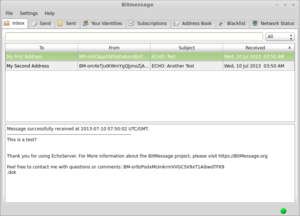Bitmessage
 PyBitmessage version 0.3.5 | |
| Original author(s) | Jonathan Warren |
|---|---|
| Developer(s) | Bitmessage Community |
| Initial release | November 2012 |
| Stable release | 0.6.3.2
/ February 13, 2018 |
| Repository | |
| Written in | Python, C++ (POW function) |
| Operating system | Windows, macOS, Linux, FreeBSD |
| Available in | English, Esperanto, French, German, Spanish, Russian, Norwegian, Arabic, Chinese |
| Type | Instant messaging client |
| License | MIT |
| Website | bitmessage |
Bitmessage is a decentralized, encrypted, peer-to-peer, trustless communications protocol that can be used by one person to send encrypted messages to another person, or to multiple subscribers.
In June 2013, the software experienced a surge of new adoptions after news reports of email surveillance by the US National Security Agency.[1]
Bitmessage was conceived by software developer Jonathan Warren, who based its design on the decentralized digital currency, Bitcoin. The software was released in November 2012 under the MIT license.[1]
Bitmessage gained a reputation for being out of reach of warrantless wiretapping conducted by the National Security Agency (NSA), due to the decentralized nature of the protocol, and its encryption being difficult to crack. As a result, downloads of the Bitmessage program increased fivefold during June 2013, after news broke of classified email surveillance activities conducted by the NSA.[1]
Bitmessage has also been mentioned as an experimental alternative to email by Popular Science[2] and CNET.[3]
Some ransomware programs instruct affected users to use Bitmessage to communicate with the attackers.[4]
References[]
- ^ a b c Max Raskin (2013-06-27). "Bitmessage's NSA-Proof E-Mail". Business Week.
- ^ Dan Nosowitz (2013-08-09). "What Are Your Options Now For Secure Email?". Popular Science.
- ^ Molly Wood (2013-08-13). "Gmail: You weren't really expecting privacy, were you?". CNet.
- ^ "Chimera Ransomware Tries To Turn Malware Victims Into Cybercriminals". International Business Times. 2015-12-04.
Further reading[]
- Bitmessage: A Peer‐to‐Peer Message Authentication and Delivery System (Jonathan Warren) - Bitmessage white paper
External links[]
- Cryptographic software
- Free software programmed in Python
- Email authentication
- Internet privacy software
- Open standards
- Peer-to-peer software
- Software using the MIT license
- Tor onion services